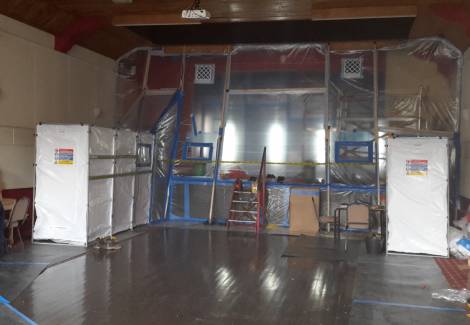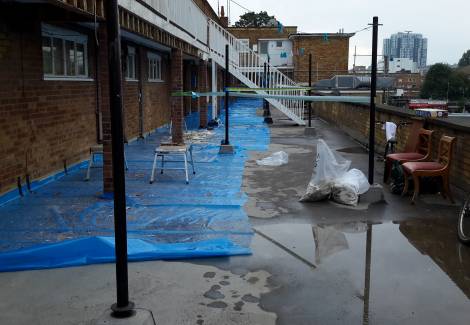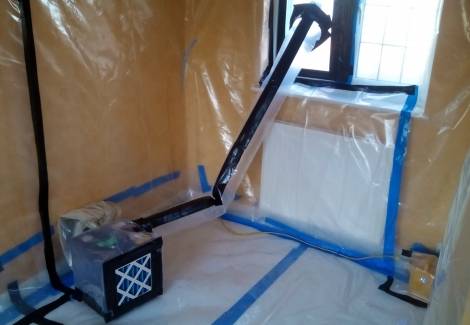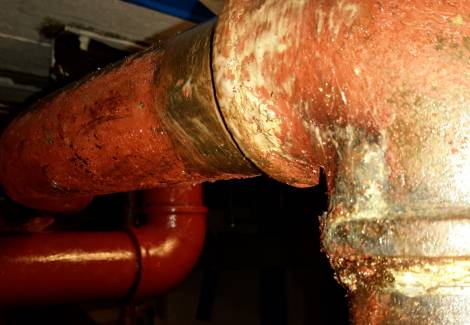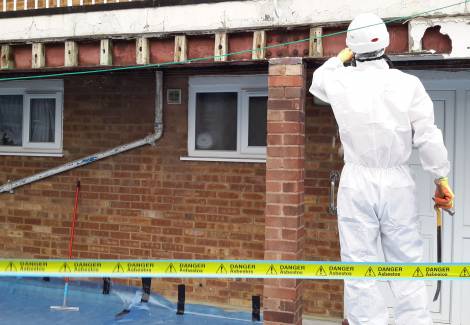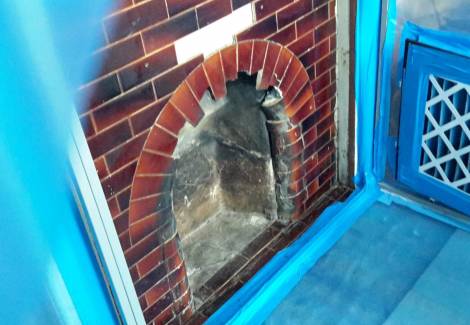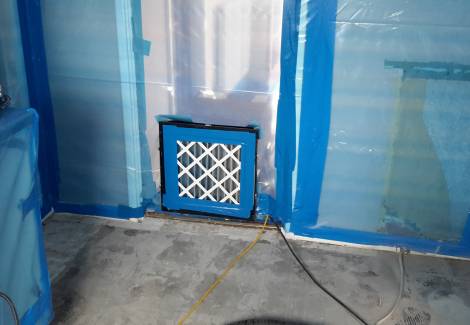Asbestos garage roof removal
Asbestos Garage Roof Removal Specialists
At Blue A Limited, we’ve been removing asbestos garage roofs safely and professionally since 2012. With over 11,000 successful projects completed across the UK, we’re one of the country’s most trusted names in asbestos removal.
Our team is fully HSE-licensed and trained to the highest industry standards, offering a complete solution from initial inspection to final reinstatement. Whether you're a homeowner, a contractor, or represent a school, hospital, or local council — we tailor our service to your needs with zero shortcuts and zero compromises.
Every garage roof we remove is treated with serious care because we understand exactly what’s at stake: your health, your safety, and your peace of mind.
Why It’s Crucial to Remove Asbestos Roofs
Asbestos might have been a miracle material decades ago, but today we know better. When damaged or disturbed, asbestos cement roofs release airborne fibers that can cause fatal respiratory diseases — often decades after exposure.
Here’s why removal matters:
- Cracked or leaking asbestos roofs pose long-term health risks
- DIY fixes often make the problem worse
- Undisturbed asbestos is low-risk, but time and weather degrade every material
At Blue A, we act before that risk escalates. Our mission is simple: save as many lives as possible by clearing asbestos before it becomes a silent killer in your home or workplace.
How We Safely Remove Your Asbestos Garage Roof
Removing an asbestos garage roof isn't just about taking a few panels down - it's about managing risk, preventing contamination, and doing things properly. Here's how we approach every removal, step by step:
1. Understanding the Material
Most garage roofs are made from asbestos cement sheets, especially corrugated panels. These are considered "lower risk" asbestos products and typically don't require formal notification to authorities for removal.
That said, they still contain asbestos fibres - and if disturbed or damaged, they can release those fibres into the air. That's why careful planning and professional methods are essential.
2. Initial Condition Assessment
Before work begins, we assess the condition of the roof and interior of the garage. We check:
- Whether the sheets are cracked, deteriorating, or leaking
- If there is visible debris or settled dust on the floor
- Whether contamination has affected stored items or the surroundings
This helps us determine whether decontamination is needed before removal and ensures the right protective measures are in place.
3. Garage Clearance
The garage owner should first check whether stored items show signs of contamination - particularly if the roof has been leaking or visibly breaking down.
- If the garage is clean and uncontaminated, we ask that all personal items be removed before we arrive.
- If dust, debris, or suspected contamination is present, items should not be moved or handled. We recommend arranging a professional decontamination service for any affected belongings.
This is also where the difference between general tradespeople and licensed asbestos contractors becomes clear.
We use H-type vacuums, designed specifically for hazardous dust - specialist equipment that most non-licensed contractors simply don't have access to.
Our equipment requires a mains power supply. If no electricity is available at the site, just let us know - we can bring a generator to ensure everything runs safely and without delay.
4. Polythene Protection - Inside and Out
Once the garage is clear, we lay down 1000-gauge polythene sheeting across both the garage floor and the surrounding outdoor area.
Why this matters:
- Interior surfaces like concrete can be cleaned - but grass, soil, gravel, or flower beds cannot.
- Any fibres or fragments that fall during removal will land on the sheeting, not the ground.
- After removal, this sheeting can be carefully disposed of as hazardous waste, keeping your property clean and compliant.
This layer of protection drastically reduces the risk of long-term contamination.
5. Safe, Controlled Removal
Once the site is prepped, our trained team begins carefully removing the asbestos sheets:
- Sheets are taken down whole, not broken, to reduce dust release
- We use controlled handling techniques and dust suppression (e.g. fine-mist spraying) where necessary
- Removed sheets are double-wrapped or bagged and placed in secure waste containers
All work is carried out according to strict asbestos safety regulations and industry best practices.
6. Decontamination
After removal, we carry out a full site decontamination to ensure no asbestos residue remains:
- Any remaining asbestos materials are cleared from the site
- The polythene protection is carefully folded and sealed as hazardous waste
- We use H-type vacuums to clean:
- Floors, sills, and frames
- Any exposed or previously covered surfaces within the work zone
This step leaves your garage clean, safe, and ready for re-use or reinstatement works.
7. Waste Disposal and Legal Documentation
All removed asbestos materials - including sheeting, polythene, and PPE - are classified as hazardous waste.
- Everything is sealed in UN-approved bags or wraps and transported to a licensed disposal site
- You will receive a Hazardous Waste Consignment Note, which:
- Serves as legal proof of disposal
- Includes a unique waste reference number
- Allows you to confirm the destination and handling of your waste, even weeks later
Providing this documentation is a legal requirement and something every professional asbestos contractor should supply.
8. Optional Re-Roofing
If required, we can help arrange reinstatement works, including the installation of a new, non-asbestos garage roof using safe modern materials.
How to Know If Your Garage Roof Contains Asbestos
Not sure what your roof is made of? Here are common signs:
- Built before 2000? That’s a red flag already.
- Look for corrugated grey cement sheets — often with small dimples or craters.
- Check for flat, weather-resistant panels that seem heavier than standard concrete.
Still unsure? Book a professional asbestos survey with Blue A. Our lab testing will confirm the presence and type of asbestos, helping you make informed, safe decisions.
What Comes After Removal – Safe, Modern Replacements
Once your asbestos roof is safely gone, we don’t leave you hanging. We offer high-performance replacements using:
- Corrugated steel roofing – durable, weather-resistant, and built to last over 35 years.
- Anti-condensation DRIPSTOP membranes – say goodbye to damp, mould, and dripping in colder months.
- Custom fascias and guttering – professionally installed for both aesthetics and functionality.
- Modern non-asbestos cement sheets – designed to look and perform just like the original asbestos cement roof, but completely safe and regulation-compliant.
With Blue A, you get both removal and replacement in one smooth process - saving you time, stress, and money.
FAQ
1. Can I remove an asbestos garage roof myself?
Technically, homeowners in the UK are allowed to remove asbestos cement sheets themselves. However, due to the serious health risks and strict safety regulations, it's strongly recommended to hire licensed professionals. Improper removal can release hazardous fibers into the air.
2. How much does it cost to remove an asbestos garage roof near me?
The cost varies depending on the size, location, and condition of your garage roof. On average, removal prices start from around £800–£2,500. For a tailored estimate, request a free quote based on your specific location and roof size.
3. What is the best material to replace an asbestos garage roof?
The most popular and durable option is corrugated steel roofing with an anti-condensation DRIPSTOP membrane. It offers excellent weather resistance, low maintenance, and can last over 35 years.
4. How do you clean an asbestos garage roof?
We do not recommend cleaning asbestos roofs. However, if cleaning is necessary, it must be done by professionals using wet methods to suppress dust, without pressure washing or dry brushing, which could release fibers.
5. Is it safe to clean an asbestos roof without professional help?
No, it's not safe. Even a small amount of disturbed asbestos can pose serious health risks. Always contact licensed professionals to handle any cleaning or removal.
6. How can I tell if my garage roof contains asbestos?
Common signs include corrugated grey cement sheets or flat panels with small dimples or craters. For certainty, an asbestos survey and laboratory test are required, especially for garages built before 2000.
Works Gallery
BLUE A LTD
VAT No: GB 153 4880 02
Company No:08355657
HEAD OFFICE
1 Handford Court
Garston Lane, Watford
WD25 9EJ
CONTACT US
phone: 01923 609858
e-mail: office@bluea.co.uk

